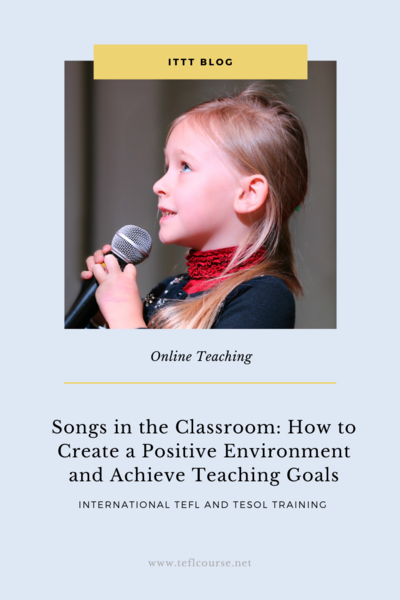Songs in the Classroom: How to Create a Positive Environment and Achieve Teaching Goals

Henry Wadsworth Longfellow once said "Music is the universal language of mankind" and it is still widely accepted today. Any language uses words to create sentences that convey messages with different tones and emotions as well as music does. Thus, bringing music to an English classroom is one good way to inspire the learners. There are tons of techniques or ideas involving music and songs that can be applied to any part of a lesson plan. It is available today in the form of online resources to use as a guideline for teachers. However, there are some arguments about how this strategy can be time-consuming and taking away the interest out of a focus lesson. In this case, the advantages outweigh the worries. Here are some astonishing benefits to convince everyone to try using songs in their classrooms.
Table of Contents
Do you want to teach English abroad? Take a TEFL course!
This post was written by our TEFL certification graduate Sirima A. Please note that this blog post might not necessarily represent the beliefs or opinions of ITTT.
Attention-grabbing technique
First of all, it is an alternative way to draw student's attention into the lesson during an engaging stage. Some teachers tend to skip an activity out of time pressure and follow the traditional structure that can cause repetitive patterns and a dull classroom atmosphere. Music can especially stimulate students when acquiring a new language. It is one of the most motivating resources regardless of age or background of the learner. The song can brighten up the atmosphere, inspire creativity and create harmony in the classroom. Once teachers capture the attention of students, the class will surely show the best result. The song choice is the most essential part which will be determined by the language level of the learners. It can be either educational songs for young students or popular update materials that people frequently hear in their everyday life for more advanced level students.

Also Read: Do I need a degree to teach English abroad?
Listening training
One of the prominent advantages is enhancing listening and speaking skills. Because songs are usually directed to native speakers, they are usually more natural and contain contemporary vocabularies, idioms, slang and expressions which are contrary to the language using in a textbook. Learners can improve their listening skills by getting used to the speed of words spoken in the songs which are closer to real-life conversation. Also, teachers can use gap-fill or finding mistake activity by letting the class fill in the missing words or phrases from the lyrics to encourage students to pay more attention and listen more carefully. Another favorable aspect is to get exposed to different accents spoken by different regions or countries such as British English or American English that can even be varied by genres as in R&B or pop music.

Also Read: Etiquette Rules in 4 Different Middle East Countries
Enhancing writing skills
Another major benefit form the songs is surprisingly a writing skill. Bob Dylan, one of the greatest songwriters in history, composed songs that honored him with the Nobel Prize for Literature. This indicates that without committing to master his writing skills, he would not be able to accomplish such extraordinary success. One of the significant values of using English songs in a classroom is to boost learners' ability in writing descriptive text as well as motivate them to learn English from generating ideas and gaining vocabulary. Teachers can, therefore, seize the opportunity to assign some activities such as creative writing, translating, or even talking about the main idea of the song or their resembling experiences. Also, the language used in the song is sometimes poetic, and for this reason, students can learn how to read between the lines, symbols, and metaphors. Moreover, by collaborating the song which contains the same use of grammar points as in the lesson, it can help learners remember better and retain them longer.
Do you want to teach English abroad? Take a TEFL course!
Using songs in the classroom is one of the numerous techniques to motivate learning experience. Songs can be great teaching tools in a classroom at any level. It depends on how to choose the right song to match the learning purpose. Consequently, teachers play an important role in selecting appropriate resources along with effective methods, activities, and guidance not only to build a good learning habit for learners but also to make English a part of their life.
Apply now & get certified to teach english abroad!
Speak with an ITTT advisor today to put together your personal plan for teaching English abroad.
Send us an email or call us toll-free at 1-800-490-0531 to speak with an ITTT advisor today.
Related Articles:
- Top 10 Qualities Every Great Teacher Should Have
- The Benefits of Having Good Rapport with Students
- The 10 Most Common Types of EFL Teaching Jobs
- What It's Like To Teach English Online: An Online Teacher Reveals Her Secrets!
- 4 Super Easy Tips for Teaching Vocabulary to Young Learners
- Getting Student Placement Right - The Best Desk Arrangements for EFL Students




